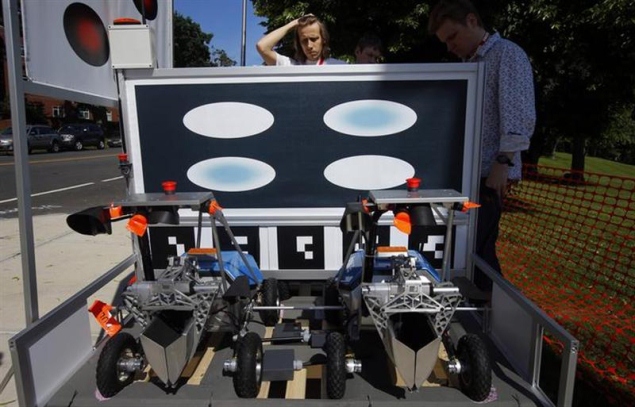- Home
- Others
- Others News
- 11 robots compete in $1.5 million NASA contest
11 robots compete in $1.5 million NASA contest
By Reuters | Updated: 6 June 2013 15:38 IST

Click Here to Add Gadgets360 As A Trusted Source

Advertisement
Eleven robots faced off in a Massachusetts field on Wednesday, showing off their ability to independently track down objects in a hunt for $1.5 million in prize money at a NASA-sponsored contest aimed at speeding technological development.
In the first day of a three day event, robots designed by teams from the United States, Canada and Estonia set out from a platform in a 2-acre (0.8 hectare) park at Worcester Polytechnic Institute in Worcester, Massachusetts, to search among rolling hills, rocks, trees and a gazebo to find geologic samples.
They operated without human control, with the goal of encouraging advancements in autonomous navigation and robotics technologies, NASA officials said.
"Improving this technology will be a huge boon, not just to NASA and space exploration, but also for countless applications here on Earth," including industrial purposes, Sam Ortega, program manager of Centennial Challenges, said in a statement.
The Centennial Challenges program, managed by NASA's Marshall Space Flight Center in Huntsville, Alabama, is part of the agency's Space Technology Mission Directorate, which develops hardware for future missions.
Robots in the contest will be required to retrieve samples in a range of shapes and sizes, from shoe-box-like forms to objects resembling tennis balls. Prizes range from $100,000 to $1.5 million, depending on the complexity of the samples retrieved.
Organizers chose the park setting to provide real-world challenges to the robots.
At 2012 event, also held at Worcester Polytechnic, no prize money was awarded because the one robot that qualified for the contest failed to collect the required samples in the allotted time.
Robots entered in the contest can weigh no more than 80 kilograms (176 pounds) and measure up to 1.5 meters (about 5 feet) square.
The program caters mostly to citizen inventors, but also small businesses and universities that have developed robots, Ortega said. Cash prizes can be awarded to US citizens only, he said, but the non-monetary "guts and glory" reward remained a strong motivator for entrants, he added.
While NASA does not claim any right to the intellectual property of the winning robots it encourages winners to start businesses, for example, the agency would like access to it as part of the competition, he said.
Technological innovations that emerge through the contest could help NASA designers overcome challenges in creating robots used in five to 10 years, Ortega said.
© Thomson Reuters 2013
In the first day of a three day event, robots designed by teams from the United States, Canada and Estonia set out from a platform in a 2-acre (0.8 hectare) park at Worcester Polytechnic Institute in Worcester, Massachusetts, to search among rolling hills, rocks, trees and a gazebo to find geologic samples.
They operated without human control, with the goal of encouraging advancements in autonomous navigation and robotics technologies, NASA officials said.
"Improving this technology will be a huge boon, not just to NASA and space exploration, but also for countless applications here on Earth," including industrial purposes, Sam Ortega, program manager of Centennial Challenges, said in a statement.
The Centennial Challenges program, managed by NASA's Marshall Space Flight Center in Huntsville, Alabama, is part of the agency's Space Technology Mission Directorate, which develops hardware for future missions.
Robots in the contest will be required to retrieve samples in a range of shapes and sizes, from shoe-box-like forms to objects resembling tennis balls. Prizes range from $100,000 to $1.5 million, depending on the complexity of the samples retrieved.
Organizers chose the park setting to provide real-world challenges to the robots.
At 2012 event, also held at Worcester Polytechnic, no prize money was awarded because the one robot that qualified for the contest failed to collect the required samples in the allotted time.
Robots entered in the contest can weigh no more than 80 kilograms (176 pounds) and measure up to 1.5 meters (about 5 feet) square.
The program caters mostly to citizen inventors, but also small businesses and universities that have developed robots, Ortega said. Cash prizes can be awarded to US citizens only, he said, but the non-monetary "guts and glory" reward remained a strong motivator for entrants, he added.
While NASA does not claim any right to the intellectual property of the winning robots it encourages winners to start businesses, for example, the agency would like access to it as part of the competition, he said.
Technological innovations that emerge through the contest could help NASA designers overcome challenges in creating robots used in five to 10 years, Ortega said.
© Thomson Reuters 2013
Comments
Get your daily dose of tech news, reviews, and insights, in under 80 characters on Gadgets 360 Turbo. Connect with fellow tech lovers on our Forum. Follow us on X, Facebook, WhatsApp, Threads and Google News for instant updates. Catch all the action on our YouTube channel.
Related Stories
Popular on Gadgets
- Samsung Galaxy Unpacked 2025
- ChatGPT
- Redmi Note 14 Pro+
- iPhone 16
- Apple Vision Pro
- Oneplus 12
- OnePlus Nord CE 3 Lite 5G
- iPhone 13
- Xiaomi 14 Pro
- Oppo Find N3
- Tecno Spark Go (2023)
- Realme V30
- Best Phones Under 25000
- Samsung Galaxy S24 Series
- Cryptocurrency
- iQoo 12
- Samsung Galaxy S24 Ultra
- Giottus
- Samsung Galaxy Z Flip 5
- Apple 'Scary Fast'
- Housefull 5
- GoPro Hero 12 Black Review
- Invincible Season 2
- JioGlass
- HD Ready TV
- Laptop Under 50000
- Smartwatch Under 10000
- Latest Mobile Phones
- Compare Phones
Latest Gadgets
- Redmi Note 15 5G
- Redmi Note 15 Pro 5G
- Redmi Note 15 Pro+ 5G
- Lava Play Max
- Poco C85 5G
- Honor Magic 8 Lite
- Jolla Phone
- Realme P4x 5G
- Asus ProArt P16
- MacBook Pro 14-inch (M5, 2025)
- OnePlus Pad Go 2
- Poco Pad M1
- Just Corseca Skywatch Pro
- Honor Watch X5
- Acerpure Nitro Z Series 100-inch QLED TV
- Samsung 43 Inch LED Ultra HD (4K) Smart TV (UA43UE81AFULXL)
- Asus ROG Ally
- Nintendo Switch Lite
- Haier 1.6 Ton 5 Star Inverter Split AC (HSU19G-MZAID5BN-INV)
- Haier 1.6 Ton 5 Star Inverter Split AC (HSU19G-MZAIM5BN-INV)
© Copyright Red Pixels Ventures Limited 2025. All rights reserved.

















